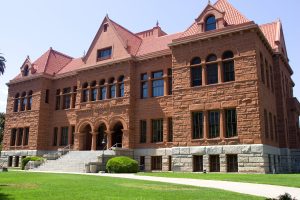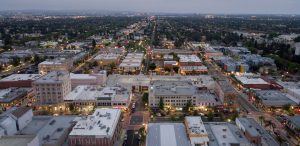
W. H. Spurgeon Building
Built in 1913 by the founder of Santa Ana, the Spurgeon Building was the tallest building in Santa Ana. The property was placed on the National Register of Historic Places in 1979. The building’s clock tower remains an iconic feature in the city’s skyline. The property is a Landmark building on the Santa Ana Register of Historical Properties (#20).
Old Orange County Courthouse
The 30,000-square-foot courthouse is the oldest court building in Southern California, and it is the historic seat of County government. The building is currently home to the Orange County History Center.
Photo Courtesy of Lisandro Orozco
Downtown Santa Ana
A view of the Downtown Historic District, including dozens of historic buildings along 4th Street, Sycamore Street, Main Street, and Broadway.Historic Preservation Element

Bowers Museum
The city boasts hundreds of historic buildings both inside and outside of local and national historic districts. The Bowers Museum is on Main Street north of Downtown. Its opening in 1936 marked a turning point for arts and cultural institutions in Santa Ana. The museum is a Landmark building on the Santa Ana Register of Historical Properties (#135).
The Kellogg House
With its asymmetrical shape, faux tower, and prominently decorated dormer, the Kellogg House is a late example of Queen Anne—style Victorian architecture. The house was originally located in downtown Santa Ana at 122 Orange Street. It was donated to the Heritage Museum of Orange County and moved to the museum’s grounds in 1980. Today, it provides hands-on opportunities to educate visitors about the Victorian era.
Howe-Waffle House
The Howe-Waffle House, built in 1889, is listed on the National Register of Historic Places, as a California Historical Point of Interest, and as a landmark building on the City’s Historic Register. The house was restored by the Santa Ana Historical Society and is currently used as a house and medical museum, fostering awareness and pride in Santa Ana’s history.
Photo courtesy of Santa Ana Public Library, image taken sometime in the 1930s
Otis Building
The Otis Building was built in 1889 and still stands today on the corner of 4th and Main. The Otis Building is on the Santa Ana Register of Historical Properties (#187) as a Landmark. The building is also a contributor to the historic fabric of the Downtown Historic District and its placement on the National Register of Historic Places.